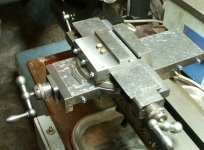Hello, I teach scraping and have several of the members plus 40,000 others around the world. Search YouTube- Richard King Scraping and you see several shows my students produced. I'm a Journeyman Machine Tool Rebuilder. If someone asked me to scrape a South Bend lathe bed, I wouldn't and get it planned or ground as the double V's are a real pain to get coplanor. Also several of my students will tell you they read the Connelly book and watched YouTube, but until I stood behind them they never figured it out. I have cut back on my classes as I'm 71...I do have one in July here in Minnesota in my small workshop. Its a 5 day class where you learn to scrape a small surface plate by hand Biax Power Scraper. I have taught in Germany at the BIAX factory and if you look at DAPRA.COM the USA distributor they advertise my classes. Keith Rucker a famous YouTuber has hosted several of my classes and has shows about them, so does NYCCNC John Saunders and Stefan Gotteswinter in Germany. Another good one is one produced by Biax Germany. In my classes you could bring the compound of your Heavy 10 and after 2 days of learning to scrape i would help you rebuild the compound. Several of my members can teach you too. Paolo MD teaches in Maryland at Tuckahoe Museum. Lance Baltzley and Adam Booth in Florida could too. Kieth Rucker , Warren Jones, Pete or Demon in the UK and 2 Brothers in Austria. There is also a Research Center in Taiwan where I taught that also has 2 of my best students teaching. PMC. I have a couple of people talking about hosting classes. Denver, Springfield VT, Portland and near Los Angeles.. they would be in late 2022 or 2023 as I'm as busy as I want to be. The July class now has 3 students, so I have room for 1 more. The cost is under $2000.00. If you wanted to scrape you 1 machine, be prepared to spend a minimum of $1000 for the tools as you will need master straightedges, handscraper, etc.



